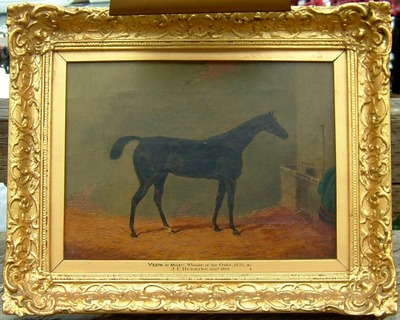|
John Fredrick Herring 1795 - 1865 |
|
 |
||||||
Price Codes
Currency: Canadian DollarsAdd to your profile and receive first notice when new works come available.
The Prices paid for all sold works are confidential. For Priceing details please call us at (250) 537-2421.
John Fredrick Herring Senior was the son of a London merchant of Dutch parentage, who had been born in America. The first eighteen years of his life were spent in London, where his greatest interests were drawing and horses. In 1814 Herring moved to Doncaster, arriving just in time to see the Duke of Hamilton's William win the St. Leger. By 1815 he had married Ann Harris; his sons John Herring Junior, Charles and Benjamin were all to become artists, while his daughters Ann and Emma both married painters.
In Doncaster, Herring earned his living as a painter of coach insignia and inn signs and his contact with a firm owned by a Mr Wood led to his subsequent employment as a night coach driver. Herrings spare time was spent painting portraits of horses for inn parlours and he became known as the `artist coachman'. Herring's talent was quickly recognised and he soon found himself painting hunters and racehorses for the gentry. In 1830, Herring left Doncaster for Newmarket, where he spent three years before moving to London. During this time, he may have received tuition from Abraham Cooper. In London, Herring got into financial difficulties and was rescued by W T Copeland, who commissioned many paintings including designs used for Copeland Spode bone china. In 1840-41, Herring visited Paris by invitation of the Duc d'Orléans, for whom he painted several pictures. In 1845, Herring was appointed Animal Painter to HRH the Duchess of Kent, followed by a commission from Queen Victoria, who was to remain a patron for the rest of his life. Herring spent the last twelve years of his life at Meopham Park near Tonbridge, where he lived as a country squire. He now broadened his subject matter and painted agricultural scenes and narrative pictures, as well as his better known works of hunting, racing and shooting. A highly successful and prolific artist, Herring ranks with Sir Edwin Landseer as one of the most eminent animal painters of the mid nineteenth century. His paintings were very popular and many were engraved, including his thirty-three winners of the St Leger and his twenty-one winners of the Derby. Herring exhibited at the Royal Academy 1818-65, the British Institution 1830-65 and the Society of British Artists (whose Vice-President he became in 1842), 1836-52.If you would like additional photos/information or to purchase this item, sell work by this artist or have a question please fill out this form:
 Pegasus Gallery Of Canadian Art: 1-800-668-6131 ~ 250-537-2421 info@pegasusgallery.ca
Pegasus Gallery Of Canadian Art: 1-800-668-6131 ~ 250-537-2421 info@pegasusgallery.ca1-104 Fulford-Ganges Rd. Salt Spring Island, BC, V8K 2S3
2-111 Robinson Road, Salt Spring Island, BC, V8K 1R6 Canada

